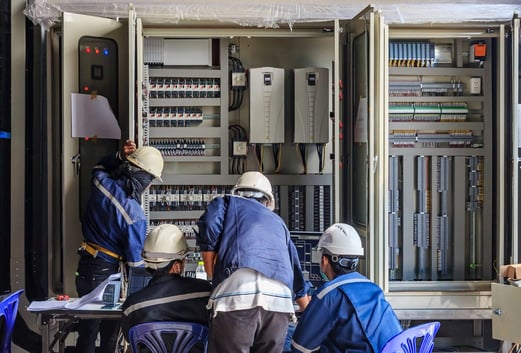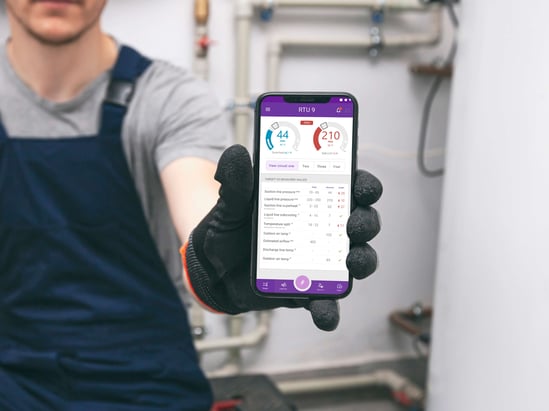Last week, we covered the current state of CRE, the top 3 current objectives of property teams, and the hybrid HVAC maintenance solution for success in the face of current headwinds.
Today, we’ll discuss how IoT Predictive HVAC Monitoring can drive improvement across building operations, tenant experience, and energy efficiency in small to mid-sized buildings serviced by packaged units.
In case you missed last week’s blog, here’s a refresher on how an IoT Predictive HVAC Monitoring Platform (like nClarity) works:
- HVAC equipment data is collected 24/7 by permanently attached IoT sensors. The data is remotely accessible via web and mobile apps.
- Cloud analytics use this data to predict potential sources of failure & help teams prioritize events by severity & operational impact.
- Automated Virtual Inspections are conducted on a regular basis, reducing the need for (and increasing the impact of) on-site service.
These platforms provide 24/7 high-resolution performance data on packaged systems, add a whole new layer of data to your CRE Building Ops analytics, and (most likely) fill in a big blindspot in your equipment management strategy across your portfolio.
Optimizing Building Operations
Current data points to unpredictable HVAC disruptions as a significant drain on FM labor capacity and source of strain on tenant relations.
According to a November 2022 survey conducted by a JLL-Owned Company, BuildingEngines, 46% of CRE professionals rank Tenant Issue Management (i.e. work orders, incidents) as the most time-consuming element of building operations.
Can you guess what respondents reported as the overwhelming majority of tenant requests (67%)? You guessed it:
Tenant comfort issues (i.e., temperature too hot/cold, after-hours HVAC).
So, while investing in work order management tech is important, reducing the source and quantity of those work orders takes precedence, especially with limited labor capacity to complete them. It’s no wonder that the second most commonly reported tenant request (33%) was a faster response to work orders/maintenance requests.
Get Cutting-Edge Mechanical Service Insights In Your Inbox
With IoT HVAC Monitoring, the most common causes of adverse temperature changes (equipment/component failures) can not only be predicted ahead of time, but also prioritized for building engineers/service teams based on severity.
This will simultaneously reduce inbound work orders (because failures happen less often) and help Building Ops teams to better manage/prioritize maintenance tasks so they can make every labor hour go further. Let’s face it, unpredictable failures consume a lot more time than precise, early diagnosis of potential sources of failure.
Improving Tenant Experience
As the survey data indicates, reducing the frequency of tenant comfort issues and getting on top of work orders quickly will go a long way in improving tenant satisfaction. IoT Predictive HVAC Monitoring can help the Building Ops team tackle both these issues.
There is one other emerging area, however, where a platform like this can be used to provide additional services to tenants and build a stronger relationship in a net lease scenario:
Data as a Service (DaaS).
In the context of CRE building operations and tenant experience, this can be defined as using data collected from PropTech to help tenants answer important questions and make data-driven decisions.
A landlord or a mechanical service provider can use an IoT Predictive HVAC Monitoring Platform to step in as a technology partner and help their tenant ensure their space is running as sustainably and efficiently as possible. When your tenant views you not only as their landlord, but also a partner, that will help to build loyalty and reduce churn in the long run.
Reducing Energy Expenses
In 2023, energy efficiency/expense reduction remains the top sustainability priority for the CRE industry, according to BuildingEngine’s report. This shouldn’t come as too much of a surprise, because the single largest manageable operating cost in a commercial building are your energy bills.
With packaged HVAC units serving over 70% of commercial space in North America, they are the largest consumer (and waster) of energy, and the biggest source of carbon emissions.
Packaged systems are also badly under-managed as a whole, making them one of the most untapped opportunities to drive energy savings and reductions in carbon footprint.
Even in larger facilities with sophisticated control systems, odds are your packaged systems are a major source of waste; from schedules, over-ventilation, refrigerant leaks and general degradation.
Side note: Based on over 5,000 building energy assessments conducted over a 10-year period by my former company, BuildingAdvice, we determined that 87% of the tested commercial space was over-ventilated and operated out of its stated schedules.
An IoT Predictive HVAC Monitoring Platform can be used to quickly identify waste from over-ventilation and poorly performing/aging equipment that would otherwise go unnoticed.
The nClarity Pulse (which collects electrical, liquid pressure, and air data, sending it to the cloud every minute) was used to identify $40,000 of wasted energy spend from systems running 24/7 in a manufacturing facility. Correcting the issue not only saved the operator money, but also helped them smash their ESG target in the first 2 months of the year.
nClarity: The Sharpest Tool In Your Operations Toolbox
In summary, integrating IoT Predictive HVAC Monitoring PropTech into your CRE Operations workflow is arguably the most effective way to simultaneously drive improvement across Building Ops efficiency, tenant experience, and building sustainability in small to mid-sized buildings serviced by packaged units.
The nClarity Predictive Maintenance Platform has been designed from the ground up with these needs in mind. Its IoT-based tech makes it cost-effective and quick to implement, and a small to mid-sized building can be brought online in as little as one day.
If you want to learn more about how nClarity can help you effectively manage your packaged systems at scale, click here.





